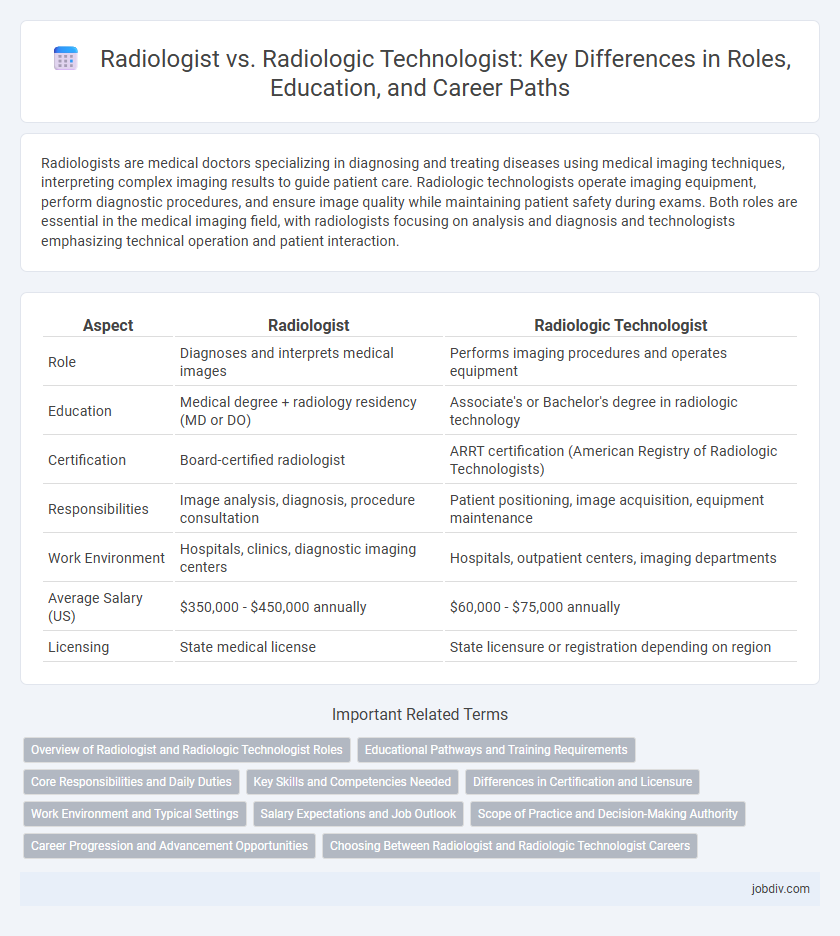Radiologists are medical doctors specializing in diagnosing and treating diseases using medical imaging techniques, interpreting complex imaging results to guide patient care. Radiologic technologists operate imaging equipment, perform diagnostic procedures, and ensure image quality while maintaining patient safety during exams. Both roles are essential in the medical imaging field, with radiologists focusing on analysis and diagnosis and technologists emphasizing technical operation and patient interaction.
Table of Comparison
| Aspect | Radiologist | Radiologic Technologist |
|---|---|---|
| Role | Diagnoses and interprets medical images | Performs imaging procedures and operates equipment |
| Education | Medical degree + radiology residency (MD or DO) | Associate's or Bachelor's degree in radiologic technology |
| Certification | Board-certified radiologist | ARRT certification (American Registry of Radiologic Technologists) |
| Responsibilities | Image analysis, diagnosis, procedure consultation | Patient positioning, image acquisition, equipment maintenance |
| Work Environment | Hospitals, clinics, diagnostic imaging centers | Hospitals, outpatient centers, imaging departments |
| Average Salary (US) | $350,000 - $450,000 annually | $60,000 - $75,000 annually |
| Licensing | State medical license | State licensure or registration depending on region |
Overview of Radiologist and Radiologic Technologist Roles
Radiologists are medical doctors specialized in interpreting medical images such as X-rays, MRIs, and CT scans to diagnose and treat diseases. Radiologic technologists operate imaging equipment to capture accurate diagnostic images and assist radiologists during procedures. Both roles require specialized training, with radiologists completing medical school and residency, while technologists undergo technical certification and clinical training.
Educational Pathways and Training Requirements
Radiologists complete extensive medical education, including a bachelor's degree, medical school, and a residency specializing in radiology, typically amounting to 13-15 years of training. Radiologic technologists require an associate or bachelor's degree in radiologic technology, including clinical training and certification, which usually takes 2-4 years. The radiologist's advanced education enables diagnostic interpretation and medical decision-making, while technologists focus on operating imaging equipment and patient care during procedures.
Core Responsibilities and Daily Duties
Radiologists interpret medical images such as X-rays, MRIs, and CT scans to diagnose and treat diseases, often working closely with other physicians to develop patient care plans. Radiologic technologists perform imaging procedures by operating specialized equipment and ensuring patient safety and comfort during scans. Both roles require precise attention to detail and collaboration, but radiologists focus on analysis and diagnosis while technologists handle imaging acquisition and equipment management.
Key Skills and Competencies Needed
Radiologists require advanced expertise in medical imaging interpretation, diagnostic analysis, and patient assessment to accurately identify conditions and guide treatment plans. Radiologic technologists must demonstrate proficiency in operating imaging equipment, ensuring patient safety, and obtaining high-quality diagnostic images under strict protocols. Both roles demand strong attention to detail, knowledge of anatomy and pathology, and excellent communication skills for effective collaboration within healthcare teams.
Differences in Certification and Licensure
Radiologists require a medical degree followed by a residency in radiology, culminating in board certification by organizations such as the American Board of Radiology (ABR). Radiologic technologists must complete an accredited radiologic technology program and obtain certification through the American Registry of Radiologic Technologists (ARRT) along with state licensure where applicable. The key distinction lies in the radiologist's extensive medical training and ability to interpret diagnostic images, while technologists specialize in operating imaging equipment under regulatory compliance.
Work Environment and Typical Settings
Radiologists typically work in hospitals, diagnostic imaging centers, and specialized clinics, where they analyze medical images to diagnose conditions. Radiologic technologists often operate in similar settings but are primarily responsible for performing imaging exams and preparing patients. Both roles require collaboration within multidisciplinary healthcare teams to ensure accurate imaging and patient care.
Salary Expectations and Job Outlook
Radiologists typically earn a median annual salary exceeding $400,000 due to their extensive medical training and specialized expertise, while radiologic technologists' median salary is around $65,000, reflecting their technical support role in imaging procedures. The job outlook for radiologic technologists is projected to grow 9% through 2031, driven by increased demand for diagnostic imaging, whereas radiologists face steadier employment growth given the high specialization and limited number of positions. Salary expectations vary significantly between these professions, aligned with differences in education requirements, job responsibilities, and clinical decision-making authority.
Scope of Practice and Decision-Making Authority
Radiologists are medical doctors who specialize in diagnosing and treating diseases using medical imaging techniques, holding full decision-making authority in interpreting images and determining patient care plans. Radiologic Technologists perform imaging examinations such as X-rays, CT scans, and MRIs, operating equipment based on protocols established by radiologists without independent diagnostic authority. The scope of practice for radiologists encompasses image analysis, clinical correlation, and treatment recommendations, whereas technologists focus on image acquisition, quality control, and patient positioning under supervision.
Career Progression and Advancement Opportunities
Radiologists, as medical doctors specializing in imaging diagnosis, have extensive career progression opportunities including sub-specialization and leadership roles in healthcare institutions. Radiologic Technologists typically advance through certifications, mastering new imaging modalities, and moving into supervisory or educational positions within radiology departments. While radiologists focus on clinical decision-making and patient diagnosis, technologists enhance skills to support advanced imaging procedures and departmental management.
Choosing Between Radiologist and Radiologic Technologist Careers
Choosing between radiologist and radiologic technologist careers depends on your interest in medical imaging responsibilities and education level. Radiologists are medical doctors specialized in diagnosing and treating diseases using imaging techniques, requiring extensive medical training and residency. Radiologic technologists operate imaging equipment and assist in patient care, offering a faster career path with certification or associate degrees.
Radiologist vs Radiologic Technologist Infographic

 jobdiv.com
jobdiv.com